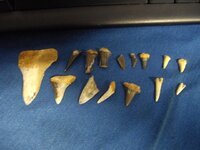pegleglooker
Bronze Member
- Jun 9, 2006
- 1,857
- 237
- Detector(s) used
- ace 250
- Primary Interest:
- All Treasure Hunting
Finding Ocean Fossils on a Mountain
On my desk I have a four-inch, triangular tooth embedded in a piece of sandstone. It is a fossil shark's tooth from an extinct 40-foot giant called Megalodon that plied the inland seas 15 million years ago. It cruised over what would become California land, slashing into the abundant fish in the shallows.
I dug that specimen from a bone bed layer on top of Sharkstooth Hill near Bakersfield, back in the 1960s when the area was accessible to amateur fossil collectors. To look at that group of great rounded hills, it seems incredible that millions of fish, marine animals, and even whale fossils have been found there, so high and far from visible water sources. I had used my pick in a gray layer of ancient sediment, uncovering a nice sampling of specimens in a fossil bone bed that seemed endless.
Finding sea shell fossils on top of a mountain always stirs your imagination. In 1500, there were various theories. One was that they were washed there by the Great Flood, but genius Leonardo da Vinci contended the shell signs had been uplifted from sea deposits by earth movements. He was the first with the idea of tectonic plates. This artist/naturalist, who bought caged birds and released them, did not promote the world flood idea, contending the water would have had no place to go from the land.
A recent article in the news media elaborated on new studies of the Sharkstooth Hill site, indicating marine animals frolicked and died in that water for as long as 700,000 years,settling into sediment on the shelf "that is arguably the richest bone bed in the world," scientists say.
Later, earthquakes heaved the undersea burial ground upward as the restless San Andreas Fault lurched and lurched again. Even older fossil layers were uncovered as sea-level surges subsided in the coming of the Ice Ages, says scientist Nicholas D. Pyenson and evolutionary biologist Jere H. Lipps, curator of the University of California Museum of Paleontology.
The waters had also teemed with sea turtles whose shells were three times larger than today's leatherbacks, plus whales, sea cows, porpoises and fish species. The montage of marine animals is apparent in the variety of bone fragments and teeth found in the richest gray layer of Sharkstooth Hill.
I didn't find any of the six-inch shark's teeth from great white shark ancestors that could reach 150 feet. Even in those days, the sharp-edged, flesh-tearing teeth were formidable instruments of death.
Something that works hangs around a long time. There were indeed giants in those days, both on land and in the sea. Ancestral seals were larger than any known today, and of course, dinosaurs ruled the land. Only whales and elephants have survived from the line-up of giants.
Fossil shells on contorted hilltops can be found on both sides of the Sacramento Valley. I am familiar with a rich, tilted layer atop Eagle Peak on the ridge in Las Trampas Regional Park near Alamo. On the other side of San Ramon Valley is the volcanic-looking Mt. Diablo, but in fact it is a "plug" of ancient, 190 million year old, greenstone/chert formed at sea and pushed up through marine fossil sediment layers of the tectonic plates by compression. The hard, reddish chert is composed of fossilized microscopic radiolaria animals of the sea.
Fossil formations occur around Oroville, too, with layers of marine sediment showing in road cuts up toward Cherokee. Fossil enthusiast Eric Gohre of Oroville has found shark's teeth in the Butte County layers and evidence of other unique life forms.
There is a mountain at Taylorsville full of fossil shells, an indication that the inland sea even covered those regions before the Sierra Nevada granite batholith rose from the depths of earth.
Since things are much more ancient than letters, it is no marvel if, in our day, no records exist of these seas having covered so many countries ... But sufficient for us is the testimony of things created in the salt waters, and found again in high mountains far from the seas.





